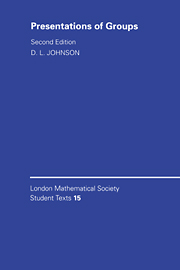Book contents
- Frontmatter
- Contents
- Preface
- 1 Free Groups
- 2 Schreier's Method
- 3 Nielsen's Method
- 4 Free Presentations of Groups
- 5 Some Popular Groups
- 6 Finitely-generated Abelian Groups
- 7 Finite Groups with few Relations
- 8 Coset Enumeration
- 9 Presentations of Subgroups
- 10 Presentations of Group Extensions
- 11 Relation Modules
- 12 An Algorithm for N/N′
- 13 Finite p-groups
- 14 The Nilpotent Quotient Algorithm
- 15 The Golod-Shafarevich Theorem
- 16 Proving some Groups Infinite
- Guide to the literature and references
- Index
- Dramatis personae
3 - Nielsen's Method
Published online by Cambridge University Press: 05 June 2012
- Frontmatter
- Contents
- Preface
- 1 Free Groups
- 2 Schreier's Method
- 3 Nielsen's Method
- 4 Free Presentations of Groups
- 5 Some Popular Groups
- 6 Finitely-generated Abelian Groups
- 7 Finite Groups with few Relations
- 8 Coset Enumeration
- 9 Presentations of Subgroups
- 10 Presentations of Group Extensions
- 11 Relation Modules
- 12 An Algorithm for N/N′
- 13 Finite p-groups
- 14 The Nilpotent Quotient Algorithm
- 15 The Golod-Shafarevich Theorem
- 16 Proving some Groups Infinite
- Guide to the literature and references
- Index
- Dramatis personae
Summary
The idea behind Nielsen's original proof of the subgroup theorem is as follows. Given a finite subset U of a free group F, perform certain operations on U (called Nielsen transformations) that reduce it to a set V of a special form (called Nielsen reduced). Since it can be shown that <U> = <V> and that V is a basis for <V>, the subgroup theorem follows in the finitely-generated case. That <U> = <V> is obvious, and the freeness of <V> follows from Proposition 1.3 in much the same way as the freeness of <B> in Chapter 2. Another point in common with Schreier's method is the crucial role played by a wellordering of F, which is used here to prove that any finite U can be carried by Ntransformations into an N-reduced V (Theorem 1).
As in the preceding chapter, we illustrate the steps in the proof by giving a specific example, and then go on to derive a series of consequences of the method, including its extension to cover the non-finitely-generated case.
The finitely-generated case
Let F = F(X) be a free group and U a finite subset of F. As the words in U together involve only a finite set of generators from X, we can assume (by Exercise 1.10) that X is finite. We think of U = (u1, u2, …, un) as an ordered set and, as usual, write l(w) for the length of w ∈ F as a reduced word in X±.
- Type
- Chapter
- Information
- Presentations of Groups , pp. 26 - 40Publisher: Cambridge University PressPrint publication year: 1997



